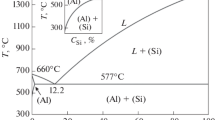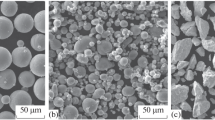This article considers questions of the effect of layer thickness during synthesis of alloy VT6 material by selective laser melting and use of a metal powder composition with a size of 63–80 μm compared with a fraction 10–63 μm. Evaluation of the structure and phase composition of alloy VT6 material prepared from metal powder composition of faction 10–63 μm (with a 30- and 60-μm layer) and 63–80 μm (with a 60 μm layer) did not reveal any differences either after selective laser alloying, after use of hot isostatic compaction, or after heat treatment. Mechanical properties of synthesized alloy VT6 material under these conditions are also evaluated. Properties obtained in specimens of metal composite powder fraction 63–80 μm are almost identical to those of specimens of metal powder composite of fraction 10–63 μm prepared by a regime with a 60-μm layer. It is demonstrated that for the method of selective laser alloying it is possible to use fraction 63–80 μm with retention of the same strengthened ductility properties as with use of fraction 10–63 μm, but with a significant reduction in surface roughness for the objects obtained.






Similar content being viewed by others
References
E. N. Kablov, “What is innovation,” Nauka Zhizn., No. 11, 16–21 (2011).
E. N. Kablov, “At the crossroads of science, education, and industry,” Ékspert, No. 15 (941), 49–53 (2015).
E. N. Kablov, “Additive technology — dominant national technological initiative,” Intellekt Tekhnol., No. 2 (11), 52–55 (2015).
A. G. Evgenov, S. I. Shcherbakov, and A. M. Rogalev, “Approval of powders of superalloys ÉP718 and ÉP648 produced by FGUP VIAM for GTE component repair by laser gas-powder deposition,” Aviats. Mater. Tekhnol., No. S1, 16–23 (2016); https://doi.org/10.18577/2071-9140-2016-0-S1-16-23.
A. G. Evgenov, S. V. Nerush, and S. A. Vasilenko, “Preparation and approval of finely dispersed metal powder of high-chromium alloy based on nickel applied to laser LMD-deposition,” Trudy VIAM, Élektron.; Nauch. Tekhn. Zh., No. 5, Art. 04 (2014); URL: http://www.viamworks.ru (referral date 08.09.2017); https://doi.org/10.18577/23076046-2014-0-5-4-4.
A. G. Evgenov, A. M. Rogalev, S. V. Nerush, and I. S. Mazalov, “Study of the properties of alloy ÉP648 prepared by selective laser melting of metal powders,” Trudy VIAM, No. 2, Art. 02 (2015); URL: http://www.viam-works.ru (referral date 08.09.2017); https://doi.org/10.18577/2307-60462015-0-2-2-2.
A. G. Evgenov, D. I. Sukhov, S. V. Nerush, and A. M. Rogalev, “Mechanical properties and structure of alloy of the Ni–Cr–W–Mo–Al–Ti–Nb system prepared by selective laser melting,” Tekhnol. Mashin., No. 3, 5–9 (2016).
D. I. Sukhov, P. B. Mazalov, S. V. Nerush, and N. A. Khadyrev, “Effect of selective laser melting parameters on formation of porosity in synthesized material of corrosion-resistant steel,” Trudy VIAM: ÉLektron. Nauch. Tekhn. Zh., No. 8, 4–8 (2017); URL: http://www.viam-works.ru (referral data 08.09.2017); https://doi.org/10.18577/2307-6046-2017-0-8-4-4.
S. Liu and Y. C. Shin, “Additive manufacturing of Ti6Al4V alloy: A review,” Materials and Design, 164, 1–23 (2019); https://doi.org/10.1016/j.matdes.2018.107552.
M. Simonelli, Y. Y. Tse, and C. Tuck, “Microstructure of Ti–6Al–4V produced by selective laser melting,” J. of Physics: Conference Series, 371, 1–5 (2012); https://doi.org/10.1088/17426596/371/1/1/012084.
P. Krakhmalev et al., “Deformation behavior and microstructure of Ti6Al4V manufactured by SLM,” Physics Procedia, 83, 778–788 (2016); https://doi.org/10.1016/j.phpro.2016.08.080.
A. M. Beese and B. E. Carrol, “Review of mechanical properties of Ti–6Al–4V made by laser-based additive manufacturing using powder feedstock,” J. of Metals, 68, No. 3, 724–734 (2016); https://doi.org/10.1007/s11837-015-1759-z.
E. Wycisk et al., “Fatigue performance of laser additive manufactured Ti–6Al–4V in very high cycle fatigue regime up to 109 cycles,” Frontiers in Materials, 2, Article 72 (2015), Vol. 2; https://doi.org/10.3389/fmats.2015.00072.
A. Khorasani, I. Gibson, U. S. Awan, and A. Ghaderi, “The effect of SLM process parameters on density, hardness, tensile strength and surface quality of Ti–6Al–4V,” Additive Manufacturing, 25, 176–186 (2019); https://doi.org/10.1016/j.addma.2018.09.002.
Z. Wang et al., “Optimization of processing parameters and establishment of a relationship between microstructure and mechanical properties of SLM titanium alloy,” Optic and Laser Technology, 112, 159–167 (2019); https://doi.org/10.1016/j.optlastec.2018.11.014.
M. Ensayed, M. Ghazy, Y. Youssef, and K. Essa, “Optimization of SLM process parameters for Ti6Al4V medical implants,” Rapid Prototyping Journal (2017); https://doi.org/10.1108/RPJ-05-201/8-0112.
A. E. Knyazev, S. V. Nerush, M. I. Alishin, and I. S. Kuko, “Study of production properties of metal powder composite of titanium alloys VT6 and VT20 prepared by induction melting and gas atomization,” Trudy VIAM: Élektron. Nauch. Tekhn. Zh., No. 11, Art. 01 (2017); URL: http://www.viam-works.ru (referral data 09.12.2019); https://doi.org/10.18577/2307-6046-2017-0-11-6-6.
V. Sh. Sufiyarov, A. A. Popovich, E. V. Borisov, and I. A. Polozov, “Selective laser melting of titanium alloy and preparation of gas turbine engine component workpieces,” Tsvet. Met., No. 8, 76–80 (2015); https://doi.org/10.17580/Ism.2015.08.11.
A. A. Popovich et al., “Mechanical property anisotropy for components prepared by selective laser melting of powder materials,” Izd. Vuz. Poroshk. Metall. Funkt. Pokryt., No. 3, 4–11 (2016); https://doi.org/10.17073/1997-308Х-2016-3-411.
A. D. Teresov et al., “Finishing treatment for titanium alloy VT6 prepared by additive production and subjected to pulsed electron beam action,” Izv. Vuz. Fizika, 60, No. 10-2, 99–104 (2017).
A. N. Kablov, “Innovative work of FGUP VIAM GNTs RF for implementing strategic direction of material development and preparation technology in the period up to 1030,” Aviats. Mater. Tekhnol., No. 1(34), 3–33 (2015); https://doi.org/10.18577/2071-9140-2015-0-1-3-33.
K. Kempen, L. Thijs, J. Van Humbeeck, and J.-P. Kruth, “Processing AlSi10Mg by selective laser melting: parameter optimization and material characterization,” Materials Science and Technology, 31, No. 8, 917–923 (2015).
B. Vrancken, L. Thijs, J.-P. Kruth, and J. Van Humbeeck, “Heat treatment of Ti6Al4V produced by selective laser melting: Microstructure and mechanical properties,” J. of Alloys and Compounds, 541, 177–185 (2012).
ASTM F2924-14, Standard Specification for Additive Manufacturing Titanium-6 Aluminum-4 Vanadium with Powder Bed Fusion.
Author information
Authors and Affiliations
Corresponding author
Additional information
Translated from Metallurg, Vol. 65, No. 7, pp. 62–68, July, 2021. Russian DOI: 10.52351/00260827_202_07_62.
Rights and permissions
About this article
Cite this article
Sukhov, D.I., Khodirev, N.A., Rogalev, A.M. et al. Effect of Metal-Powder Composition Fraction and Layer Thickness on Structure and Mechanical Properties of Alloy VT6 Synthesized Material Prepared by Selective Laser Melting. Metallurgist 65, 760–768 (2021). https://doi.org/10.1007/s11015-021-01213-x
Received:
Published:
Issue Date:
DOI: https://doi.org/10.1007/s11015-021-01213-x




